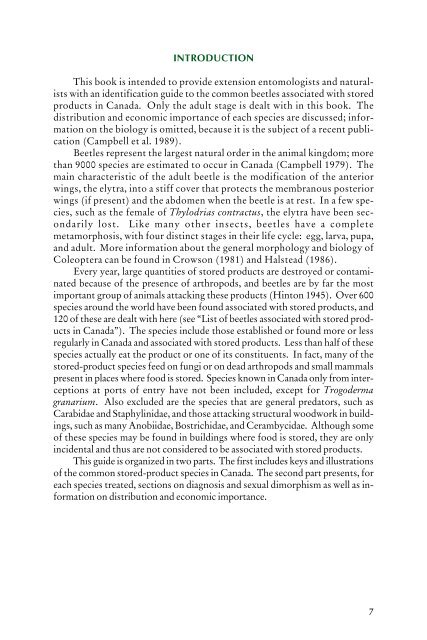Beetles Identification Guide
Beetles Identification Guide
Beetles Identification Guide
You also want an ePaper? Increase the reach of your titles
YUMPU automatically turns print PDFs into web optimized ePapers that Google loves.
INTRODUCTION<br />
This book is intended to provide extension entomologists and naturalists<br />
with an identification guide to the common beetles associated with stored<br />
products in Canada. Only the adult stage is dealt with in this book. The<br />
distribution and economic importance of each species are discussed; information<br />
on the biology is omitted, because it is the subject of a recent publication<br />
(Campbell et al. 1989).<br />
<strong>Beetles</strong> represent the largest natural order in the animal kingdom; more<br />
than 9000 species are estimated to occur in Canada (Campbell 1979). The<br />
main characteristic of the adult beetle is the modification of the anterior<br />
wings, the elytra, into a stiff cover that protects the membranous posterior<br />
wings (if present) and the abdomen when the beetle is at rest. In a few species,<br />
such as the female of Thylodrias contractus, the elytra have been secondarily<br />
lost. Like many other insects, beetles have a complete<br />
metamorphosis, with four distinct stages in their life cycle: egg, larva, pupa,<br />
and adult. More information about the general morphology and biology of<br />
Coleoptera can be found in Crowson (1981) and Halstead (1986).<br />
Every year, large quantities of stored products are destroyed or contaminated<br />
because of the presence of arthropods, and beetles are by far the most<br />
important group of animals attacking these products (Hinton 1945). Over 600<br />
species around the world have been found associated with stored products, and<br />
120 of these are dealt with here (see “List of beetles associated with stored products<br />
in Canada”). The species include those established or found more or less<br />
regularly in Canada and associated with stored products. Less than half of these<br />
species actually eat the product or one of its constituents. In fact, many of the<br />
stored-product species feed on fungi or on dead arthropods and small mammals<br />
present in places where food is stored. Species known in Canada only from interceptions<br />
at ports of entry have not been included, except for Trogoderma<br />
granarium. Also excluded are the species that are general predators, such as<br />
Carabidae and Staphylinidae, and those attacking structural woodwork in buildings,<br />
such as many Anobiidae, Bostrichidae, and Cerambycidae. Although some<br />
of these species may be found in buildings where food is stored, they are only<br />
incidental and thus are not considered to be associated with stored products.<br />
This guide is organized in two parts. The first includes keys and illustrations<br />
of the common stored-product species in Canada. The second part presents, for<br />
each species treated, sections on diagnosis and sexual dimorphism as well as information<br />
on distribution and economic importance.<br />
7
















